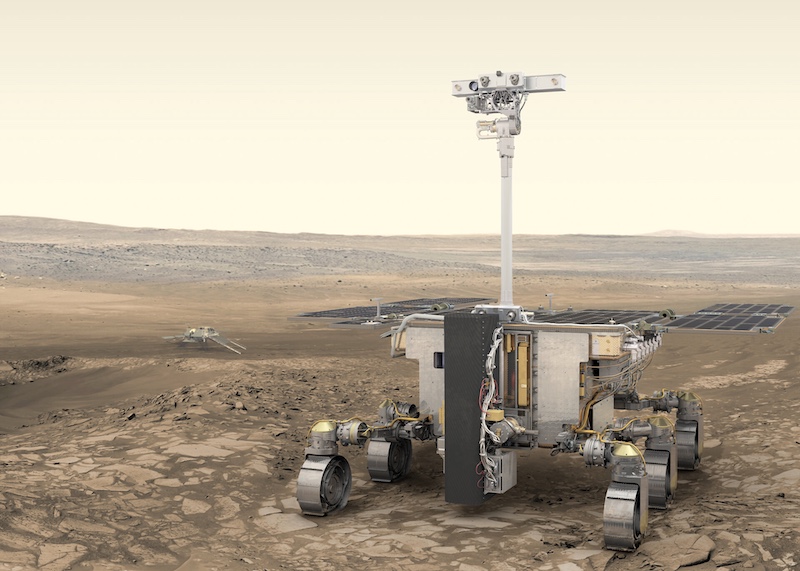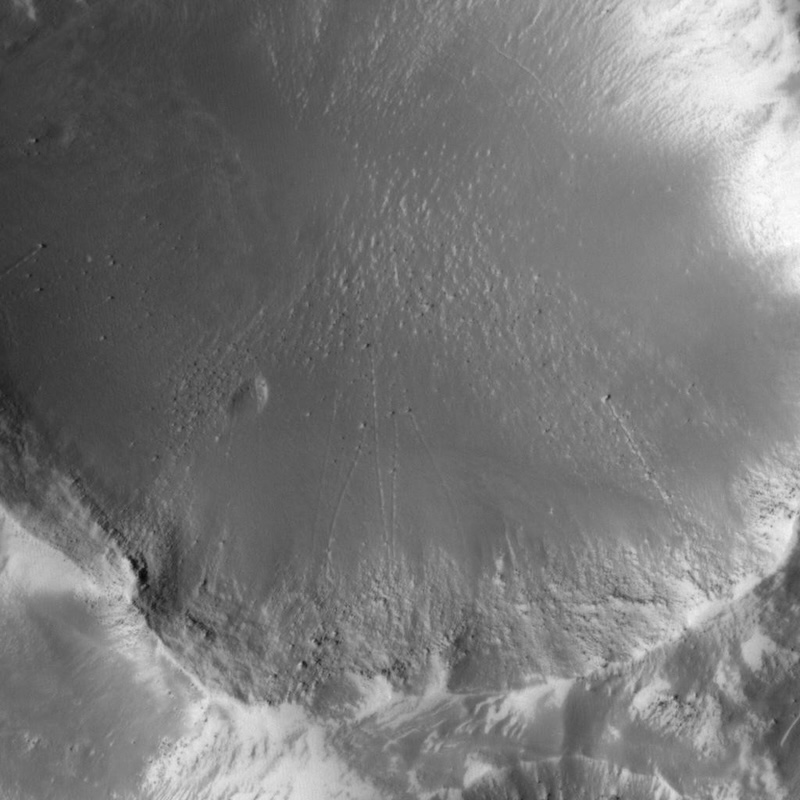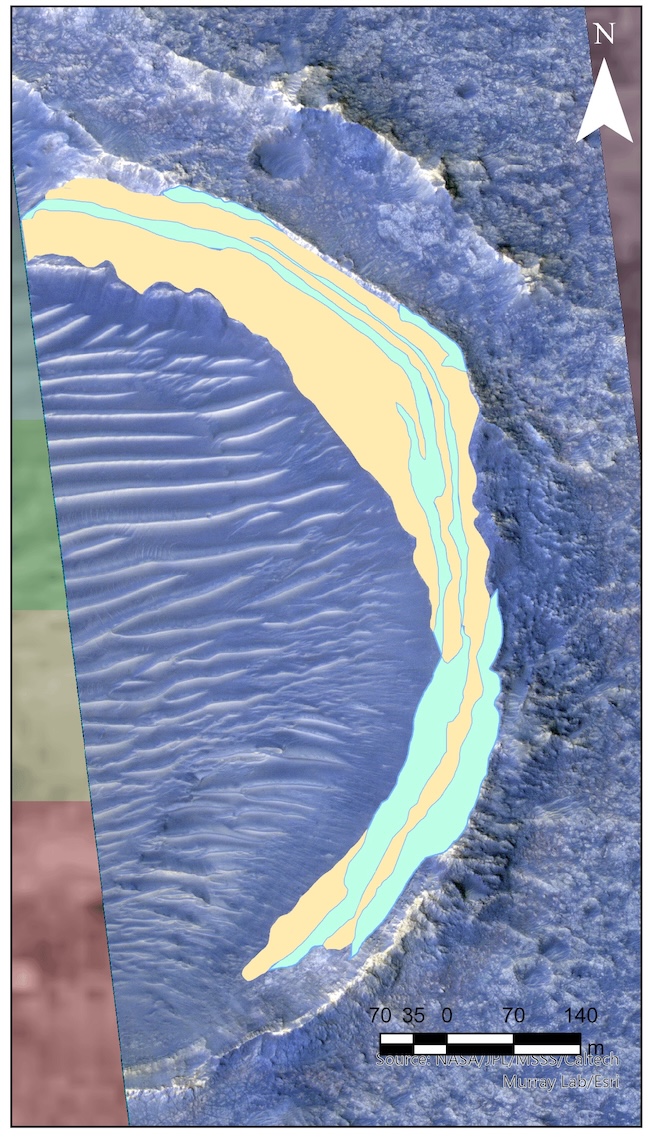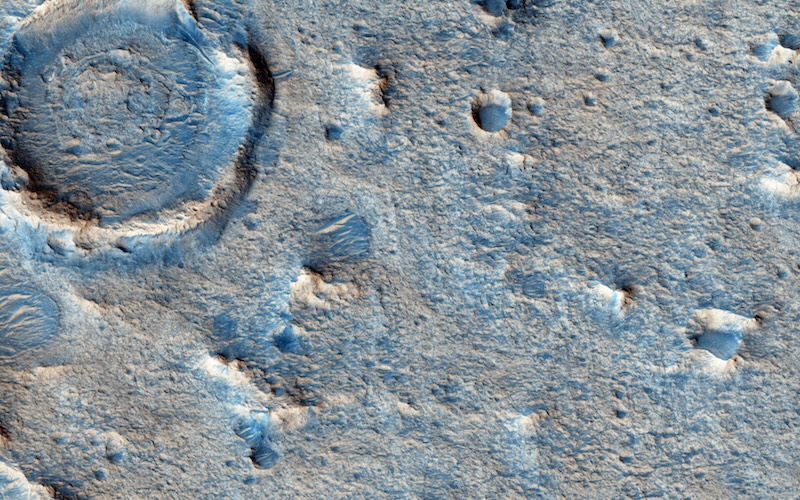Now Reading: Rosalind Franklin rover: Finding Mars life might be easy
-
01
Rosalind Franklin rover: Finding Mars life might be easy
Rosalind Franklin rover: Finding Mars life might be easy


- The European Space Agency’s Rosalind Franklin rover will launch to Mars in 2028. It will search for evidence of ancient life in the Oxia Planum region.
- The stuff of life could be closer to where the rover will land than scientists first thought.
- Rockfalls and ancient floods could have brought organic materials close to the landing site, where the rover can easily sample them.
How the Rosalind Franklin rover could find ancient life on Mars
The European Space Agency’s Rosalind Franklin rover is scheduled to launch to Mars in 2028. It will search for evidence of past life in Mars’ Oxia Planum, a large plain rich in clay minerals that formed in water billions of years ago. Now, an international team of researchers has found, in two new studies, that the chances of finding such evidence might be even better than previously thought. They said on September 11, 2025, that natural geologic processes such as rockfalls and ancient floods could have brought organic-rich rocks close to the rover’s landing site.
So the rover might not have to travel far to find the stuff of life. Needless to say, that would be a huge bonus for the mission.
The Rosalind Franklin rover is part of the ExoMars program. The other part is the Trace Gas Orbiter, which launched in 2016 and is still orbiting Mars today.
The rover is named after Rosalind Franklin, a British chemist and DNA research pioneer.
The researchers presented their findings at the EPSC-DPS Joint Meeting 2025 in Helsinki, Finland (September 7-12, 2025). Read the first paper here and the second paper here.
?#EPSCDPS2025 press release: The Rosalind Franklin mission’s chance of finding evidence of past life on Mars has been boosted by two studies that show that the rover won’t have to travel far to find materials potentially laden with organic molecules: bit.ly/epscdps_stufflife
— Europlanet (@europlanetmedia.bsky.social) 2025-09-11T09:10:37.189Z

Rolling stones
There are two ways that organic material could be brought close to the rover’s landing site. First, there are stones rolling in rockfalls. NASA’s Mars Reconnaissance Orbiter has been able to see many of these from orbit. They range from smaller than 8 feet (2.5 meters) to about 26 feet (8 meters) across. The researchers found 48 such rockfalls in the vicinity of the rover’s landing spot, using deep-learning algorithms. Aleksandra Sokolowska at Brown University in Rhode Island is the lead author of the first paper. She said:
We have reasons to believe that fresh rockfalls could be very common. More rockfalls are likely waiting to be found, as our manual follow-ups on small areas revealed many more than our semi-automatic search over the whole Oxia Planum region.
The discovery of rockfalls in Oxia Planum opens up the exciting possibility for the rover to increase the diversity of its samples with material that would otherwise be inaccessible.
These rocks – from mounds, crater walls and other steep cliff-faces – would also have been partially protected from the harsh radiation that hits Mars’ surface. Notably, that means that any organic molecules in them would have a better chance of remaining intact.

Ancient floods
The other way that organics could end up close to the Rosalind Franklin craft involves clays transported by ancient floods. Clays are ideal for preserving organic molecules, and crater walls in Oxia Planum contain multiple layers of clays. Interestingly, craters at lower elevations have thicker layers of clay. And overall, the average thickness of these layers increases downslope of ancient highlands to the north-west of Oxia Planum.
The lead author of the second paper, Ananya Srivastava at Western University in Ontario, Canada, said:
These results, particularly the variation in the layer thickness, imply that the clays may have originated elsewhere before being transported and deposited in the Oxia basin.
The clays could record a far wider range of ancient Martian climatic conditions than previously believed if they came in multiple pulses from various source regions. This diversity of environments improves the prospect that organic molecules were preserved under favorable conditions, strengthening the chances of uncovering the most thrilling discovery: clues for life beyond Earth.


More about the Rosalind Franklin rover
Presently, Rosalind Franklin is the European Space Agency’s first rover mission to Mars. And it is designed specifically to search for traces of ancient life. It uses solar panels for power and includes the following instruments:
- CLUPI: Close-Up Imager
- Enfys: Infrared Spectrometer for ExoMars
- Ma_MISS: Mars Multispectral Imager for Subsurface Studies
- MicrOmega: visible plus infrared imaging spectrometer
- MOMA: Mars Organic Molecule Analyser
- PanCam: Panoramic Camera
- RLS: Raman Spectrometer
- WISDOM: Water Ice and Subsurface Deposit Observation On Mars
Plus, the rover also has a drill. It will be able to obtain samples to a depth of 6.5 feet (2 meters). At that depth, any organic materials would have a better chance of being protected against the strong ultraviolet radiation from the sun.
The rover has six wheels, like its NASA counterparts, Perseverance and Curiosity. Overall, it will be capable of traveling between 160-330 feet (50-100 meters) per day. Plus, it can do wheel-walking to help navigate difficult terrain. Wheel-walking articulates motion around the axes and adjusts the rover height and angle with respect to the surface. This motion gives very good traction in soft soils and on high slopes. As a result, the rover will be able to overcome obstacles, like rocks, as large as its wheels.
Also, similar to NASA rovers, Rosalind Franklin will have two cameras in the front, at the top of a tall mast.
It will also use a parachute for landing. In fact, Rosalind Franklin will use the largest parachute to date for its descent and landing, at 115 feet (35 meters) wide.

Landing site in Oxia Planum
Oxia Planum is a 124 mile-wide (200 km) clay-bearing plain located inside the Oxia Palus quadrangle on the eastern border of Chryse Planitia. NASA’s Viking 1 lander landed in Chryse Planitia in 1976. The plain lies between the Mawrth Vallis outflow channel to the north-east and the Ares Vallis outflow channel to the south-west.
In addition, Oxia Planum contains one of the largest regions of exposed clay-rich rocks on Mars, which are around 3.9 billion years old. This shows that water was once abundant in the area.
Additionally, there are numerous valleys – ancient riverbeds – in the region as well. The exposed rocks exhibit different compositions, indicating a variety of deposition and wetting environments billions of years ago.
Moreover, volcanic deposits might cover some of the earliest clay deposits. Significantly, this could also help preserve any organic molecules or other biosignatures within the clays.
The ExoMars mission
The ExoMars mission has two parts: Rosalind Franklin and Trace Gas Orbiter (TGO). Trace Gas Orbiter was launched in 2016 and has been orbiting Mars ever since. TGO studies Mars’ atmosphere, focusing on trace gases such as methane and others. Although in tiny amounts, these gases provide important clues about Mars’ atmosphere, geology and possible biological processes.
The Trace Gas Orbiter instruments include:
- ACS: Atmospheric Chemistry Suite
- CaSSIS: Color and Stereo Surface Imaging System
- FREND: Fine Resolution Epithermal Neutron Detector
- NOMAD: Nadir and Occultation for MArs Discovery
The Rosalind Franklin rover mission will be an exciting one. With a history of water, clays and organics in the region, it’s a great location to search for evidence of possible past life, even if it’s only microbes. And, conveniently, rockfalls and ancient floods might just make that task even easier.
Bottom line: Rockfalls and ancient floods could have brought organic materials to the region the Rosalind Franklin rover will explore on Mars, making it easier to find traces of possible ancient life.
Source: Will Rosalind Franklin See The Rolling Stones?
Source: Multi-scale Spectral Characterization of Clay-Rich Crater Walls in Oxia Planum
Read more: ExoMars rover named for Rosalind Franklin
Read more: NASA announces Mars rock as a potential biosignature
The post Rosalind Franklin rover: Finding Mars life might be easy first appeared on EarthSky.
Stay Informed With the Latest & Most Important News
Previous Post
Next Post
-
 01From Polymerization-Enabled Folding and Assembly to Chemical Evolution: Key Processes for Emergence of Functional Polymers in the Origin of Life
01From Polymerization-Enabled Folding and Assembly to Chemical Evolution: Key Processes for Emergence of Functional Polymers in the Origin of Life -
 02Two Black Holes Observed Circling Each Other for the First Time
02Two Black Holes Observed Circling Each Other for the First Time -
 03How New NASA, India Earth Satellite NISAR Will See Earth
03How New NASA, India Earth Satellite NISAR Will See Earth -
 04Thermodynamic Constraints On The Citric Acid Cycle And Related Reactions In Ocean World Interiors
04Thermodynamic Constraints On The Citric Acid Cycle And Related Reactions In Ocean World Interiors -
 05Φsat-2 begins science phase for AI Earth images
05Φsat-2 begins science phase for AI Earth images -
 06Hurricane forecasters are losing 3 key satellites ahead of peak storm season − a meteorologist explains why it matters
06Hurricane forecasters are losing 3 key satellites ahead of peak storm season − a meteorologist explains why it matters -
 07Binary star systems are complex astronomical objects − a new AI approach could pin down their properties quickly
07Binary star systems are complex astronomical objects − a new AI approach could pin down their properties quickly



















